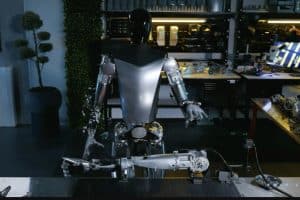- 💼 Tesla’s Optimus project is expanding with the opening of 61 new job positions.
- 📍 All new job openings are based in Palo Alto, California.
- 🛠️ Among the job categories are manufacturing roles, including Systems Engineer, Manufacturing Engineer, Photo Production Supervisor, and Mechatronics Engineering Technician.
- 🤖 Other positions include Python Generalist, Controls Engineer, Motion Planning Engineer, and more.
- 🚀 Tesla aims to ship several Optimus units by 2025, although the main challenge lies in ensuring the humanoid robot’s utility.
In the heart of Silicon Valley, Tesla’s Optimus project is on the cusp of a revolutionary leap forward, heralding the dawn of a new era in robotics and automation. With the announcement of 61 new job positions in Palo Alto, California, the Optimus project is poised to accelerate its momentum and redefine the landscape of artificial intelligence and humanoid robotics.
Expanding Horizons: The Optimus Project’s Growth
Tesla’s Optimus project has been a beacon of innovation since its inception, pushing the boundaries of what’s possible in the realm of robotics. With the opening of 61 new job positions, the project signals its commitment to expansion and advancement, laying the groundwork for a future where intelligent machines seamlessly integrate into everyday life.
Diverse Opportunities: Job Categories and Roles
The array of job categories within the Optimus project reflects its multifaceted approach to robotics development. From manufacturing roles such as Systems Engineer and Manufacturing Engineer to specialized positions like Photo Production Supervisor and Mechatronics Engineering Technician, there’s a wealth of opportunities for professionals to contribute their expertise and passion to this groundbreaking endeavor.
Pioneering Innovation: The Quest for Utility
As Tesla sets its sights on shipping several Optimus units by 2025, the project faces a formidable challenge: ensuring the utility of humanoid robots in real-world applications. While the ability to walk and perform tasks is impressive, the true test lies in creating robots that are truly useful and impactful in various settings. Overcoming this hurdle will require relentless innovation and collaboration across disciplines.
Bridging the Gap: Robotics and Artificial Intelligence
At the heart of the Optimus project lies the convergence of robotics and artificial intelligence (AI), two fields that are poised to shape the future of technology. By leveraging AI algorithms and advanced robotics systems, Tesla aims to create robots that not only mimic human movement but also possess the cognitive capabilities to adapt and learn in dynamic environments. This fusion of technologies holds the key to unlocking new possibilities and driving progress in automation.
A Visionary Mission: Shaping Tomorrow’s World
Beyond the confines of the laboratory, Tesla’s Optimus project embodies a visionary mission to redefine the human-machine interface and pave the way for a future where robots are not just tools, but companions and collaborators. From enhancing productivity in manufacturing to revolutionizing healthcare and beyond, the potential applications of humanoid robotics are vast and far-reaching.
To see Tesla’s list of jobs related to Optimus, click here.





